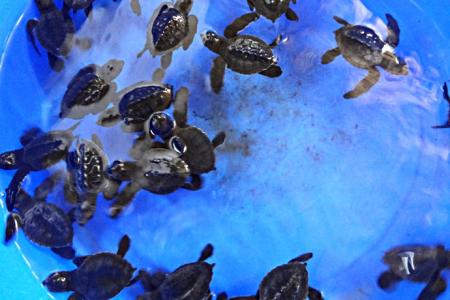Guidelines for Relocating a Sea Turtle Nest
Nests should ONLY be moved if they are at risk from flooding (situated below the high water mark), erosion from wind or waves, predation or human disturbance.
Ideally, nests should be moved within 4-6 HOURS of nesting AND NO LATER THAN 12 HOURS AFTER DEPOSITION.
Moving a nest should be done BEFORE 10am or AFTER 6pm. If this is not possible, and the eggs are moved during the hot hours of the day, ensure that the eggs are shaded and AWAY FROM DIRECT SUNLIGHT. Use a kanga / piece of material / vegetation to cover the eggs during the move.
Requirements
- Bucket
- Tape measure
- Gloves or plastic bag
- Note book and pen
Removing the eggs
- Carefully dig down to the top egg. Measure the distance (cm) from the top of the sand to the first egg and record in note book
- Prepare the bucket by placing a 1 inch layer of sand at the bottom
- Use surgical gloves or a CLEAN plastic bag to remove the eggs one at a time, from the nest to the bucket. Count the eggs as you move them to the bucket.
- When moving the eggs to the bucket, DO NOT TURN THEM. Keep the eggs in an UPRIGHT POSITION.
- Sand should not be placed between the eggs. Keep the eggs clean of sand.
- When the bottom egg has been removed from the nest, measure the distance from the top to the bottom of the nest and record in note book.
- Measure the width of the egg chamber (this is normally about 25cm across).
- DO NOT FORGET TO COUNT THE EGGS.
Transporting the eggs
- Hold the bucket firmly while moving to the new site to avoid damage or disturbance to the eggs.
- The eggs should be moved as quickly as possible. Cover them with leaves or a kanga and keep them out of direct sunlight.
Constructing the new nest
It is important to remember that turtle nests are FLASK-SHAPED. This shape should be replicated when constructing the new nest or the mortality rate will be very high.
- Situate the new nest well above the spring (bamvua) high water mark, preferably in a shaded area and where there are no roots.
- The sand should contain some moisture.
- Dig the new nest in the SHAPE OF A FLASK, using the measurements taken from the original nest.
- VERY CAREFULLY, using gloves/plastic bag, place the eggs from the top of the bucket into the nest chamber, being careful not to turn them. The eggs should be touching each other, with minimum sand.
- COUNT THE EGGS AS YOU PLACE THEM IN THE NEW NEST & record in note book.
- When all the eggs are in the nest chamber, cover the nest with damp subsurface sand (do not place hot surface sand on the eggs) and press down firmly.
- Note the location of the new nest.

